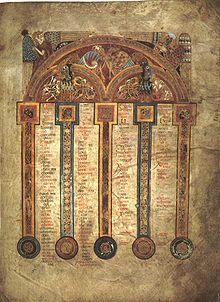

Eusebian canons, Eusebian sections or Eusebian apparatus,[1] also known as Ammonian sections, are the system of dividing the four Gospels used between late Antiquity and the Middle Ages. The divisions into chapters and verses used in modern texts date only from the 13th and 16th centuries, respectively. The sections are indicated in the margin of nearly all Greek and Latin manuscripts of the Bible, but can be also found in periphical Bible transmissions as Syriac and Christian Palestinian Aramaic (Codex Sinaiticus Rescriptus) 5th to 8th century,[2][3] and in Ethiopian manuscripts until the 14th and 15th centuries, with a few produced as late as the 17th century.[4] These are usually summarized in canon tables at the start of the Gospels. There are about 1165 sections: 355 for Matthew, 235 for Mark, 343 for Luke, and 232 for John; the numbers, however, vary slightly in different manuscripts.[5]
The canon tables were made to create a sense of divinity within the reader’s soul, to understand and reflect upon the various colors and patterns to achieve a higher connection with God.[6]
- ^ D. C. Parker, An Introduction to the New Testament Manuscripts and their Texts, Cambridge University Press, 2008, p. 24.
- ^ Sebastian P. Brock, 'Review of Alain Desreumaux, Codex sinaiticus Zosimi rescriptus (Histoire du Texte Biblique, 3), The Journal of Theological Studies, NEW SERIES, 50 (1999), p. 766.
- ^ Christa Müller-Kessler and Michael Sokoloff, The Christian Palestinian Aramaic New Testament Version from the Early Period. Gospels (A Corpus of Christian Palestinian Aramaic, IIA; STYX: Groningen, 1998), pp. 94–95, 97, 139–140, 168–169.
- ^ Carla Zanotti-Eman, "Linear Decoration in Ethiopian Manuscripts", in African Zion, ed. Roderick Grierson (New Haven: Yale University, 1993), p. 66. ISBN 0-300-05819-5
- ^ Bruce M. Metzger, Manuscripts of the Greek Bible: An Introduction to Palaeography, Oxford: Oxford University Press, 1991, p. 42. ISBN 978-0-19-502924-6
- ^ Nersessian, Vrej (2001). The Bible in the Armenian Tradition. London: The British Library. pp. 70&74. ISBN 0-89236-640-0.